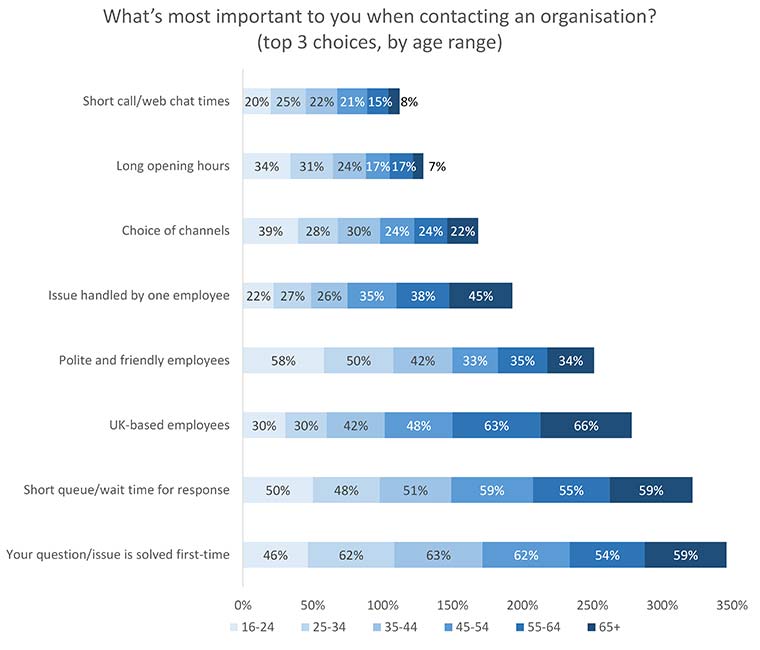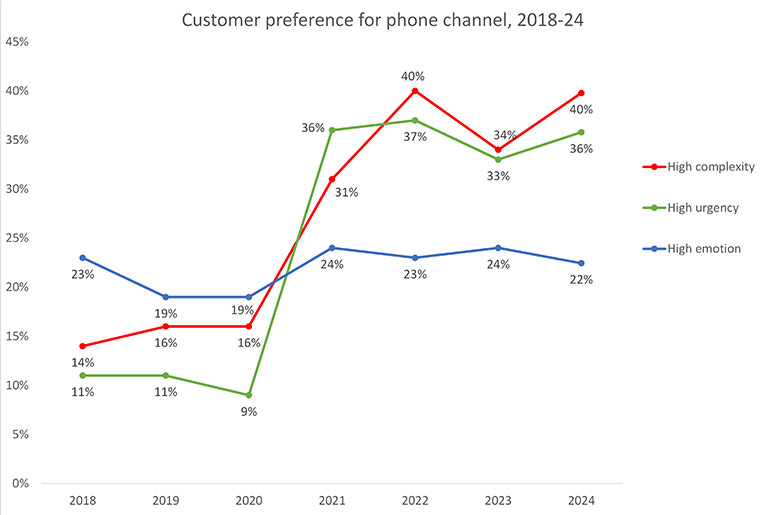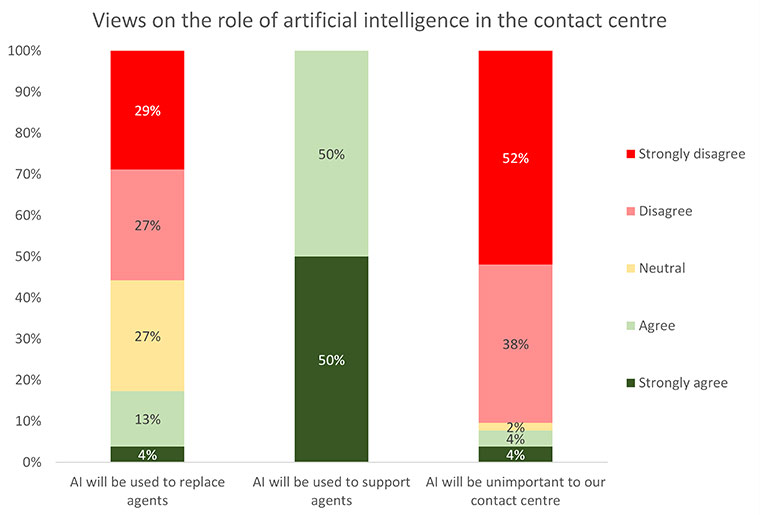Based on surveys with 1,000+ UK customers and hundreds of UK contact centres, “Exceeding UK Customer Expectations” is the latest research report from ContactBabel.
It provides insight into what’s driving UK customer decisions, identifies the frontline issues that most impact on customer experience and advises businesses on the solutions available to solve them.
Here are five key findings from the report.
Here are five key findings from the report.
1. Be Polite and Friendly to Younger Customers
Survey respondents were provided with a list of eight factors that affect customer experience and asked to rank them in order. The chart below shows the proportion of respondents placing them in their top three, segmented by age group.

Younger people rate having polite and friendly agents as the most important factor impacting CX, being even higher than a short queue time or first-contact resolution.
This may be because the youngest age group have the least experience of dealing with businesses and contact centres, perhaps lacking some of the confidence that comes with years of speaking with businesses, and to have a friendly and approachable agent is valued very highly.
2. Long Queue Times are Customers’ Biggest Bugbear
A key finding – which won’t come as a surprise – is that 81% of survey respondents felt that the queue time was too long very often or fairly often, and was the negative issue most often experienced by customers.
Customers have a point: average queue times have risen from 34 seconds in 2017 to 116 seconds in 2024.
It is also worth noting that customers’ perceptions of how long they have been queueing are far higher than reality: past ContactBabel research asked customers to estimate their typical wait time, which was reported to be 23 times higher than the actual industry average at the time, showing that the effect of queue times on customer experience is exceptional.
3. Younger customers are less loyal
Customers were asked if, in the past 12 months, they had left any of the seven business types listed or had used a competitor instead because of poor customer experience.
Retailers had the greatest level of customer defection, with 23% of survey respondents using a competitor because of a poor customer experience.
There was a distinct pattern: the younger the customer or prospect, the more likely they are to have reported changing supplier or using a competitor because of poor CX.
Many decisions are made before individuals become actual customers: a slow-loading website; not being able to get through to the contact centre to ask a pre-sales question; a lack of information about a time-sensitive buying factor – all these and more will feed into the customer (or prospect) experience, and are included in the defection figures along with poor experiences of the contact centre itself.
The focus and preference of younger customers for digital channels (including self-service) means that there is less opportunity for an exceptional personalised customer experience to take place – for example, in the telephony channel or in a shop – which could support long-term customer loyalty.
4. Customer Preference For Telephony is Growing – For Some Types of Interaction
Considering that the prevalence of digital channels and self-service has increased so much in recent years, it is a surprise to see that the preference for the phone channel as the first port-of-call has risen so much, particularly for complex and urgent matters.

A customer does more than just pick the quickest and easiest channel to hand: few people could argue that waiting in a phone queue rather than writing a quick email is a logical choice if customers are indeed only driven by doing what is ostensibly the least effort for them at the time.
Instead, they choose a channel which they believe will be the least effort to them in the context of the overall specific interaction, which will not involve re-explaining the issue to multiple employees over numerous channels, or taking days to communicate back-and-forth over an asynchronous channel such as email.
Customers may choose the channel which is the least effort to them personally, but only where they are also confident that their issue will be resolved fully.
Often, this means telephony.
5. AI is Seen as Augmenting Agents, Not Replacing Them
AI is often seen as being used to oust humans from their jobs.
However, contact centres generally do not believe that AI will replace agents: only 17% agree to some extent that this would be the case, with 56% disagreeing.
It is worth noting that after a gradual movement over the past couple of years towards a growing feeling that AI will replace agents, this year’s views are very much of the opinion that they will not.
There was unanimous agreement that AI would support human agents, with all respondents agreeing or strongly agreeing that this would be the case, reducing risk, speeding up responses and providing customers with higher quality resolutions.
52% strongly disagreed that AI would be irrelevant to their contact centre, with almost complete agreement that AI will affect contact centres of all sizes. This figure is growing year on year as AI becomes more widespread and the benefits better understood.

“Exceeding UK Customer Expectations 2024-25” is available for free download from https://www.contactbabel.com/exceeding-uk-customer-expectations/
Author: Megan Jones
Published On: 11th Sep 2024
Read more about - Industry News, ContactBabel















